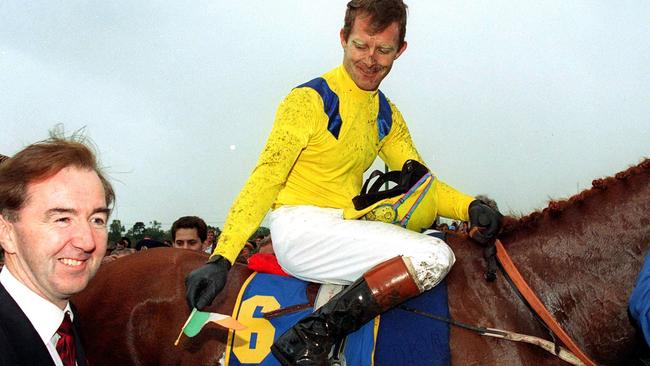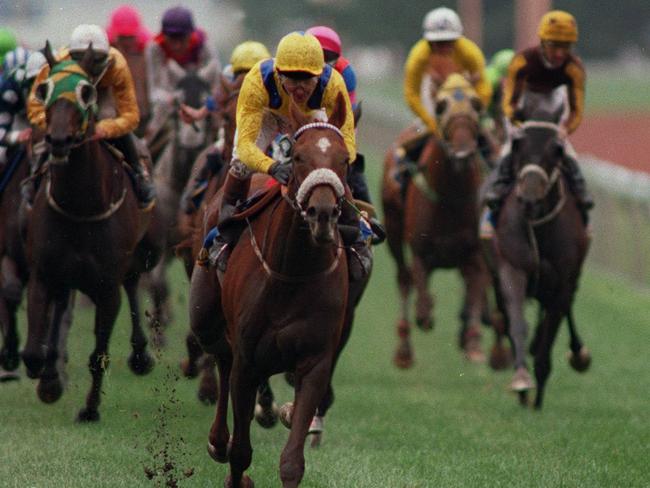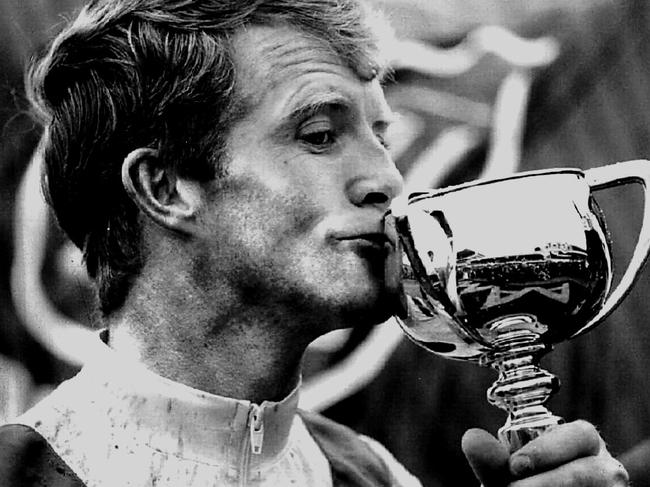How Dermot Weld and Vintage Crop helped revolutionise Melbourne Cup
WHEN Irish stayer Vintage Crop raced away with the Melbourne Cup all those years ago, the nation’s great race was changed forever - but that historic moment almost never happened.

SuperRacing
Don't miss out on the headlines from SuperRacing. Followed categories will be added to My News.
- Early mail: Melbourne Cup tips
- Cup favourite’s nightmare draw
- Cup form: Finding winner made easy
- Sunlight towers over boys in Coolmore
WHEN Irish stayer Vintage Crop raced away with the Melbourne Cup all those years ago, the nation’s great race was changed forever — but that historic moment almost never happened.
On the 25th anniversary of the Dermot Weld-trained Vintage Crop’s famous win, his jockey Michael Kinane has revealed how the gelding was very nearly left stranded in Ireland when a thick Dublin fog almost forced the trip to be cancelled.
“Everything was put in place for the horse to leave Ireland but then a fog descended on Dublin airport,’’ Kinane said.
“The plane that Vintage Crop was due to board tried twice to land but couldn’t do it.
“If the horse didn’t make that flight to Stansted Airport to join Drum Taps for the international flight, the trip would have been off.
“Dermot (Weld) had given up but then he got a phone call and said to get the horse to the airport within the hour.

“The pilot had found a window so he could land the plane and we had to be there to be ready to board straight away.’’
Vintage Crop did board that plane out of Ireland, made the connecting flight from England – and the rest is history.
The Melbourne Cup suddenly became a race of growing international importance.
Weld returned to win the Melbourne Cup again in 2002 with Media Puzzle, Japan’s Delta Blues won in 2006, France celebrated successive wins with Americain (2010) and Dunaden (2011) and German stayer Protectionist scored in 2014.
The northern hemisphere-trained stayers have been coming in record numbers in recent years and they will be there in force on Tuesday trying to take away the greatest prize in Australian sport.
And it all started because of Weld’s vision and ambition.
“Dermot was very instrumental in the internationalisation of racing,’’ Kinane said.
“He won the Belmont Stakes with Go And Go (1990) and then travelled to Hong Kong when their International raceday was in its infancy and won the Bowl.
“He was starting to spread his wings but this (Melbourne) was a long way to fly.’’
Kinane revealed it took two years of planning to get Vintage Crop to the 1993 Melbourne Cup.

“Dermot tried to come out in 1992 but the logistics were insurmountable,’’ Kinane said.
“But then the quarantine rules were changed and so were some of the stop-off points to make it happen.
“I think back on it now and it was lucky it happened this way as Vintage Crop was a much better horse in 1993.’’
Kinane was also preparing himself for racing the Australian way. He rode for two seasons in Hong Kong where the tight racing on smallish tracks was more like racing Down Under than in Europe.
“Because I had been based in Hong Kong, I got to know quite a few of the Australian jockeys so the Melbourne Cup wasn’t totally alien to me,’’ he said.
“I was in my second season in Hong Kong so the speed of the race there prepared me for Australia – and I knew I had the horse, too.’’
Weld and Kinane might have thought they had brought the right horse down under for the Melbourne Cup – but very few others did.
‘I don’t think most people gave him any chance,’’ Kinane said.
“We had not had a run for about 150 days and people felt he couldn’t be race-fit for a Melbourne Cup. We flew under the radar a bit.

“Drum Taps was the favourite but we took a ‘walk’ in the market a bit.’’
Melbourne Cup day was wet, cold and miserable – but Kinane said Vintage Crop felt right at home.
“The rain took the sting out of the ground and I knew Vintage Crop would like the conditions,’’ he said.
“It was my first ride at Flemington but I had done my research. I watched as many replays of the Melbourne Cup as I could and I spoke to two good friends of mine, your Australian jockeys, Ron Quinton and Kevin Moses about the race so I felt good about everything. ’’
In the race itself, Kinane got into the back of Drum Taps, ridden by Frankie Dettori in a midfield position.
“I knew I could trust Frankie so I was happy to follow him,’’ Kinane said. “Vintage Crop didn’t like the tightness of the field in the early part of the race but he eventually got sorted into a nice rhythm.
“We gradually started to improve our position and on the turn I thought we were going to be hard to beat.
“I remember Te Akau Nick had got away to a big lead in the straight but once I worked my way out, I knew I had plenty of horse left. He did the rest and won easily.’’
Kinane was aware of the Melbourne Cup’s reputation but he wasn’t expecting what happened next.

“I heard it was the race that stops a nation but I wasn’t quite prepared for what it is,’’ he said.
“When I got to Australia and won the Cup, then I could see how much it meant to people here.
“I’ve never witnessed an occasion or a reception quite like it.’’
Vintage Crop wasn’t the best horse Weld has trained, or the best horse Kinane ever rode, but he was the right horse for the Melbourne Cup.
Kinane said Vintage Crop was a natural stayer, very clean-winded, and easy to get fit which meant he was the ideal type to make the long trip from Ireland and contest the famous Flemington two-miler.
“I think back on it now and I have only fantastic memories of a great achievement,’’ Kinane said.
“I had been riding for Dermot for a good few years and it always his dream to get a horse capable of going there and winning the Cup.
“The race made such an impression on him when he was a young guy learning his training in Australia.’’
Vintage Crop did return to contest the Melbourne Cup in 1994 and again in 1995 but with mixed results.
The Irish stayer was the Cup favourite in 1994 just prior to hurting himself in a track accident at Sandown, which was used as the quarantine and training facility for the internationals in those days.
“Vintage Crop ran in 1994 with 17 stitches in his elbow,’’ Kinane revealed.

“Dermot said to me don’t knock him around, he said look after the horse, so I kept him on a wide run that year and he ran seventh (behind Jeune).
“But in 1995, he ran an unbelievable race for third behind Jeune. He really flew home in the race but when I pulled him up, he was barely able to walk, he had expended so much energy.
“I only rode one other horse who did that was Theatrical the day I rode him in slow ground at Baden Baden in Germany. He tried so hard that day.’’
Kinane, 59, retired from the saddle in 2009, but not before he got to partner the best horse he ever rode, Sea The Stars.
The champion jockey had ridden so many greats over the years including Galileo, Giant’s Causeway. Rock Of Gibraltar, Barathea and Montjeu but none compared with the mighty Sea The Stars.
During an unbeaten three-year-old season in 2009, Sea The Stars with Kinane in the saddle won the English 2000 Guineas, English Derby, Eclipse Stakes, International Stakes, Champion Stakes and finally the Prix de l’Arc de Triomphe.
“Sea The Stars was the best horse I rode,’’ Kinane said.
“He had no weakness, most horses have a weakness, he had none. Your champion, Winx, is like that. She is a special ‘filly’.
“I was fortunate enough to get into the parade ring with Tom Magnier for the Cox Plate and you could see the greatness in her eye.
“She was the calmest on the course that day. She is a phenomenal horse.’’
Kinane then went back to Vintage Crop, reflected on the 25 years since his Melbourne Cup win and wondered what might have been if the Irish stayer didn’t create history that day.
“If Vintage Crop had not run well or achieved something that day, maybe others would not have followed,’’ he said.
“Everyone might have thought it was too hard to do, too far to travel, can’t make it happen.
“But someone had to win the first Melbourne Cup and fortunately it was us.’’
Kinane has been a guest of the Victoria Racing Club this spring but Weld has not made the trip to Melbourne.
“It’s a pity Dermot is not here, but if he gets a horse good enough I’m sure he will try and come back to win the Cup.’’
So, what happened to Vintage Crop after he ran third to Doriemus in the 1995 Melbourne Cup?
Vintage Crop never raced again and lived out the rest of his life at Ireland’s National Stud. He died four years ago.
A life-sized statue of Vintage Crop was built in his honour and is situated at Ireland’s famous The Curragh raecourse.
“Vintage Crop made a huge impact back home and people went to visit him at the National Stud, he was a tourist attraction,’’ Kinane said.
“When the horse died, his owner, Dr (Michael) Smurfit, had him buried at his golf course in County Kildare. It’s a nice resting place for him.’’
